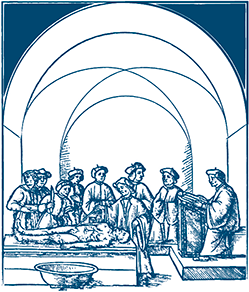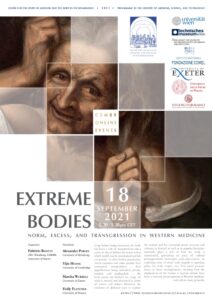Extreme Bodies

Extreme Bodies
Norm, Excess, and Transgression in Western Medicine
Organised by
Fabrizio Bigotti
18 September 2021 – 2.30 PM (CET)
Long before being measured, the body has been a unit of measurement and a canon in that it defines the norm within which health can be maintained and life can persist.
As all in-formal parameters, whose existence and value predate their conceptual manipulation – their apprehension being individual, private, implicit, and prelinguistic – the
the body-canon has defined the range of what is normal and abnormal in terms of excess and defect. However, the existence of different ways to express the normal and the abnormal across societies and cultures, in learned as well as in popular literature, inevitably plays a role in how the body is experienced, generating an array of cultural presuppositions, stereotypes, and expectations. Amongst these, a moral and political component should also be taken into account. Indeed, violating a norm implies an ethical stance towards perfecting, challenging
challenging or transforming accepted conventions. An example of this is how corpulence and fat have been dealt with across the ages, being used to highlight the belonging to the upper class, or – on the contrary – gluttony, intemperance, and incapability of abiding by shared societal mores. Sponsored jointly by the University of Vienna and the CSMBR, this panel presents some of these entanglements, showing how the implications of the ‘nature vs nurture debate’ have been a constant preoccupation in Western medicine and culture more generally.

‘Ticking Bodies’: Idioms, Numbers, and the Measurement of the Pulse
Yijie Huang
Since antiquity, pulse diagnostics had been erected upon the awareness that the pulse tells not a body in undoubted excess of agitation, but one naturally normal yet subject to alternation in pathological conditions. Such a notion attached to the examination of pulse frequency an emphasis on assessing the norm, that is, the periodicity of the pulse in perfect health, in the first place. The primary enquiry about the normal pulse lingered in The Physician’s Pulse-Watch (1707 & 1710) written by the English physician John Floyer (1649-1734), but the way in which he conducted it is of striking epistemological hybridity.
This paper discusses the multiple methods of Floyer’s designation of the normal and abnormal pulses through his use of idioms and numbers. It first compares Floyer’s glossary of pulse characteristics with those in the Galenic pulse doctrine and later commentaries, and examines Floyer’s strategy of adapting the ancient pulse-lore and squaring it into the spectrum of his own sensation. It then pays attention to the numbers of pulsebeats per minute that Floyer observed, recorded, and, more important, categorised and paired with corresponding qualitative idioms.
About the Speaker…
Yijie Huang is a PhD student in the Department of History and Philosophy of Science, University of Cambridge researching early modern English medicine and natural philosophy, while she also pays attention to the cross-cultural medical exchange between East Asia and Europe during the seventeenth century. Her doctoral project explores knowledge and practice of taking the pulse in late seventeenth-century English medicine and the fledging innovation of pulse counting in this period.

‘Transgressive Bodies’: Bodyweight and Excess in Early Modern Germany
Holly Fletcher
In this paper, I will examine understandings of the excessive body in early modern Germany, focusing in particular on the role of bodyweight within ideas about excess. Scholars have shown that the excessive body could be imagined as an overflowing vessel in this period, as the body would expel superfluous food and drink through the bodily fluids of sweat, vomit, urine and excrement. This understanding was closely connected to contemporary medical theory, as excessive consumption disrupted the balance of the humours, and the body’s reaction to excess would also depend on a person’s complexion
complexion.
As well as considering medical perspectives on excess, I will focus my discussion on the cultural associations of the excessive body, exploring how such bodies could take on moral, religious and even political meaning. Ultimately, I will connect this discussion of excess and transgression to the focus of scales and limit values, as I question what constituted excessive behaviour in this context? What were the ‘norms’ of bodyweight and consumption, and in turn, how far were fat bodies characterised as excessive or transgressive?
About the Speaker…
Holly Fletcher completed her BA, MPhil and PhD (2020) at the University of Cambridge. Her doctoral research, which was funded by the Cambridge Trust, explored the cultural significance of bodyweight in early modern Germany. From October 2021 she will take up a postdoctoral position at the University of Manchester, working on the Wellcome Trust funded project ‘Sleeping Well in the Early Modern World: An Environmental Approach to the History of Sleep Care’.

‘Heavy bodies’: Understanding Body Weight and Weight-Watching in Eighteenth-Century England
Marsha Wubbels
Today, body weight plays a tremendous role in our defining, diagnosing, and curing of excess fat. This connection between body weight and unhealthy fatness was not always so intrinsic, however. This paper will discuss eighteenth-century concerns with and interest in body weight and weight-watching and argue that these differed significantly from our own. It will demonstrate that eighteenth-century English society did not share our concept of ‘overweight’, but that many individuals pursued a perfect balance between their ingesta and excreta.
Weight-loss, however, was not the motivation behind these weight-watching practices. It will also argue that for the much of the eighteenth century, body weight did not yet play a significant role in the medicalisation of corpulency, and that corpulency was generally defined and diagnosed using other criteria.
About the Speaker…
Marsha is a third-year PhD student at the University of Exeter, working on popular practices concerning diet, exercise, and body weighing in eighteenth-century England. She completed both her BA and MA at the University of Exeter with a focus on the history of medicine. The title of her MA thesis was: “Indisposed to Stir’: the role of motion, exercise and physical (in)capacity in discussions of the fat body in English Health Literature, 1680-1820’.

Scaling Size? Measuring and Quantifying Corpulence in Medicine
Alexander Pyrges
This paper will explore how the physical form of the corpulent body was translated into numbers and which role the numeric understanding of corpulence played in the medical literature. The numeric assessment of bigness entered the medical literature through the case studies of corpulent individuals, which first appeared in late 17th century learned periodicals and multiplied during the course of the 18th century. Providing detailed measurements of individuals, not always patients, such case studies arguably
arguably replicated early modern reports on persons considered “monsters” or wonders of nature due to their particular bulk. In both kinds of publications, a variety of different vertical and lateral as well as mass measurements was explored. Initially case-based it was more and more frequently employed in hygiene and public health debates and from there became instrumental in the hegemonic shift from a horizontal classification to a vertical scale of corpulence in medicine.
About the Speaker…
Alexander Pyrges is a research fellow at the Institute for the History of Medicine at Julius-Maximilians-Universität Würzburg, Germany. He is the author of the book Das Kolonialprojekt EbenEzer. Formen und Mechanismen protestantischer Expansion in der atlantischen Welt des 18. Jahrhunderts (Stuttgart: Steiner 2015). Currently he studies the history of corpulence, more particularly, the concepts, metaphors, and images surrounding excessive girth in medical and popular texts between 1500 and 1900.
About the Organiser...
Fabrizio Bigotti is an intellectual historian with a specialisation on the history of medicine, science and technology in the late medieval and early modern period (1300-1700). He studied at the University of Rome ‘La Sapienza’, where he achieved a PhD in History of Philosophy and History of Ideas (2012), with a thesis on the influence of Galen’s medicine and psychology on the late-Renaissance philosophy (Ottimo/Summa cum Laude). Since then, he has held postdoctoral
Postdoctoral and Research positions at The Warburg Institute of London, the University of Exeter, the Folger Institute of Washington DC, the University of Padua, Valencia and Bucharest. He is currently Senior Research Fellow at the Institut für Geschichte der Medizin, Julius-Maximilians-Universität Würzburg, Director of the CSMBR and co-editor of the Series Palgrave Studies in Medieval and Early Modern Medicine (PSMEMM).







